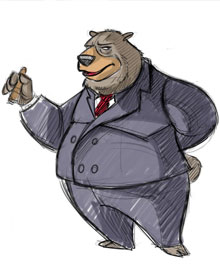Gabriele Ranfagni is an Italian animator who started out in Florence in the early days as an illustrator before he turned to animation. He’s worked on more than 40 productions and held multiple roles doing storyboarding, stop motion, character design, concept art, 2D and 3D animation. For several years he also worked as a teacher at both the Florence International School of Comics and NEMO Academy, an important school for training animators in Italy, where he held classes in figure drawing and traditional animation. In this interview he tells us about his life as an animator in Europe and a bit about the people who helped him along the way.
First off, please tell us a little bit about yourself and how you got started with animation.
Hello everybody. I’ve worked professionally with illustrations since I was 16 years old but I started with traditional animation later. This was in 1995 at a small studio in Florence in Italy. I was looking for work as an illustrator, I was a watercolor artist at this point in my life, but when I applied for a job I got the studios mixed up. What I thought was a studio producing illustrations turned out to be an animation studio. I spent the next five years there, working on traditional animation and as a clean up artist for in between poses.
So this was the way by accident that I discovered animation, although it was something I had always been drawn towards. To see your drawings come to life is a wonderful feeling every time, and it’s what caught me at the start. I remember Deluxe Paint and Sprite Animation for games, drawing with only a mouse in the early 1990’s together with my best friend Alberto who’s a 3D animator as well on his Amiga 500. Those were great days.
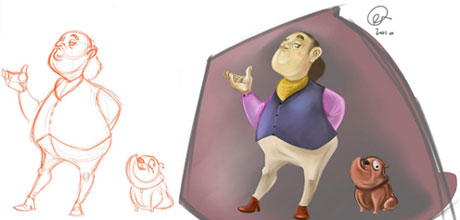
What happened from here?
After this I moved to Luxembourg in 2000 to work with storyboarding and layout. I was fairly new to this field and my supervisor at the time was Philippe Ferin who came from Disney in Paris. He is a great storyboard artist and working with him helped me improve my skills so much.
From here I went onto working as a freelance animator on various projects both in Italy and other places in Europe, I also taught traditional animation to students at NEMO and The International School of Comics in Florence. After ten years of mainly storyboarding I came back to creating the actual animations about three years ago. Animation for me isn’t only a job, it’s a passion.
What’s your most recent projects?
In the past year I’ve worked on some interesting things, I just came back to Italy after spending a few months in Glasgow in Scotland working for Axis Animation as a Lead Animator on a commercial trailer for Sony.
Before that I was in the town of Valence, in France, at a studio called TeamTO. Their projects are truly amazing. I worked as a Senior Character Animator and I arrived only at the end of the production of “Oscar’s Oasis”, a 3D animated series [view a sample clip below]. The style of cartoon resembles “Ren and Stimpy”, or something created by Tex Avery.
I was there for the final month and a half and it was a great experience. I worked in Maya and every day I would create 6-8 seconds of animation. The supervisor on this project, Michel Rimbauld, was really good which you can see in the quality of the end product. Thanks to him I’ve discovered the strength of K.I.S.S. (Keep It Simple Stupid), a fundamental for every animation. The studio itself is really nice and the working environment is positive.
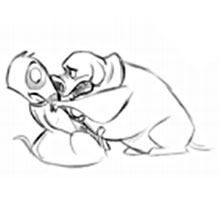
What’s the most interesting project you’ve worked on?
There’s been so many. Since 1995 I’ve worked on more than 40 projects. There’s been features, tv-series, games and I’ve done traditional animation, clay and stop motion, 2D and 3D, concept art, character design, layout and storyboards.
To me every project is interesting because from every project we can learn something 🙂
What would you say is important for beginners who are just getting started in this field?
You should try to kill your ego in order to move forward. This is the first thing to do. Animation means satisfaction but also frustration. Every day you can learn from everything because the work of an animator is reproducing something living. So use your eyes to take everything in, try to be part of life and not only the audience. Study, always try sculpting your work to refine it. Remember also to ask questions and share your work with other animators. As Ken Fountain once said to me; the other animators LOVE to help you. Envy is what kills animation.
Ken was my teacher for 14 weeks during a workshop in Jason Ryan’s online school iAnimate. This is a great resource for animation training. Ken really brought me to the point where I understood what is important in a shot and what can give you emotions. Jason and Ken are both animators from Dreamworks. Great animators.
You’ve worked as a teacher in traditional animation and gesture drawing at NEMO Academy and International School of Comics in Florence. Are there any student exercises you’d like to share?
Sketch everyday! I wake up every morning and before going to work I do 30 minutes of sketching. Sometimes I go outdoors to sketch from real life and sometimes I use Virtual Pose, which is a virtual life drawing studio and good for finding QuickTime rotatable movie clips of different modeling poses.
What makes for a good animation?
Think simple and clear. Try to not overanimate but animate only the mechanics of body that can tell you something in the scene. Learn how to talk with the eyes and create microexpressions. A subtle animation can be much stronger and more effective than a complex mechanical animation. This is what I’ve learnt from my errors 🙂
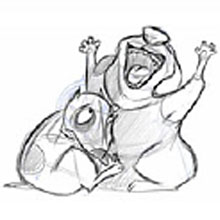
Can you give us a quick breakdown of how the 2D animation process works from initial concept to complete animation in 3D?
For me it’s really important to plan everything in 2D before creating the 3D animation. I start off by drawing the complete scene, this work includes how to get timing and spacing of poses to come out right.
With this done I can concentrate afterwards on the 3D animation itself and get clear shapes and poses to become really sincere and realistic. Keeping these two processes separate helps me to be sure of every step of my workflow, and also I can run it by my supervisor to check that things are progressing in a way that works with the overall project.
What software do you use?
I use Plastic Animation Paper (PAP) to plan out my animation, Jason Ryan from DreamWorks Animation uses Digicel Flipbook which is common in a lot of the leading studios. These are both good software, and Plastic Animation Paper is free. To sketch my animations I use my tablet.
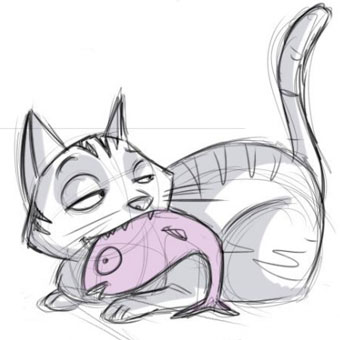
Do you have any good tips for our members on what’s important to look at when you create an animation showreel?
Don’t put it all, but put only the best. That’s not so easy because it requires self-criticism and taking a step back to distance yourself from your work. So again, try to switch off your ego and find the right balance to pick out your greatest stuff. Don’t worry about how long it is but rather how good it is. If you think your good animation was only 20 seconds long, then ok, put a reel of 20 seconds. It will be 20 seconds of pleasure.
Have you had any mentors along the way during your career? Are there any specific people who’s work you admire and find inspirational?
Many mentors but I would underline the most important, in addition to the ones I’ve already mentioned.
Leonardo Mattioli who was one of the best illustrator in Italy, he died 13 years ago. He was my teacher at Art School of Florence and taught me what drawing was all about.
Luca Chiarotti, when I was just 16 years old he took me into his own studio to teach me illustration. Now he’s teamed up with the founders of NEMO, an important animation school in Italy.
Michael Mattesi, author of FORCE figure drawing books, who brought me the light 🙂
Pablo Navarro who’s a great animator, great artist and great person. He taught me a lot with just a few words.
And overall my father for teching me how to stay on my feet, walk the path to arrive at the target, even at those times when circumstances in life can make it difficult. Thanks, I know you’re looking down from the sky.
Thanks to everyone, and also thanks to SimplyMaya for this interview.
Thank you Gabriele for sharing your experiences with us. What does the future hold for you next?
In the long run I would like to work in the USA or Canada, but for now in this coming year I’m planning on Spain or Germany. I’ve got my motorbike so I like to move around and look for new adventures around Europe. There’s always another interesting project waiting out there…
